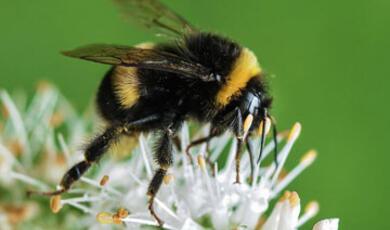Microbial Master-Chemists
Share
- Details
- Text
- Audio
- Downloads
- Extra Reading
Microbial chemistry makes bread rise and cheese mature, and turns grapes into wine. Microbes help make engine fuel, life-saving antibiotics and nano-particle sunscreens. Without fungi and bacteria, the world would sink under its own waste within days, since only these microbes have the ability to degrade complex polymers such as the lignin in plants.
Might we be able to harness this amazing power of microbial degradation to help remove the human-made plastic mountain, or clean up toxic waste sites?
Download Text
Microbial Master-Chemists
Professor Robin May
11th January 2023
Hidden out of sight, beyond the resolution of the human eye, one could be forgiven for thinking that the microbial world is a tranquil place. However, nothing could be further from the truth. Depending on where it is taken from, a gram of soil may contain anything from 1 million to 1 billion bacteria, together with a similar number of fungal cells and perhaps 10-100 times as many viruses. Within this extraordinarily crowded environment, competition is intense and so to maintain their ecological niche, microbes have evolved chemistry skills that exceed anything yet achieved in even the most advanced pharmaceutical laboratory. In this lecture we will take a scenic tour of some spectacular microbial molecular wizardry and witness how this unseen chemistry impacts the human world for both good and ill.
Food, Fermentation and The Magic of Life Without Oxygen
We start our journey with the most fundamental part of biological chemistry – how to gain useful energy from food. All living cells share a common ‘energy currency’ – the molecule Adenosine Triphosphate (ATP). This biological equivalent of the dollar is the high-energy ‘fuel’ that cells use to drive movement, build complex molecules, or power elaborate behaviours like cell division. Regardless of whether you are a carnivorous lion or a wood-decomposing fungus, ultimately the food you eat is converted into ATP in order to power all of the energy-requiring functions of that organism. The most efficient way to do this is so-called ‘aerobic respiration’; a process that uses oxygen to break down complex molecules in food, creating lots of ATP and releasing carbon dioxide as a by-product.
Most higher organisms, including humans, are strictly dependent on aerobic respiration – if humans are deprived of oxygen, the consequences are swift and irreversible. However, many microbes have evolved alternative pathways that allow them to continue to create ATP from nutrients even in the absence of oxygen. Although less efficient than aerobic respiration, some of these alternative fermentation pathways turn out to have major benefits for us. Every time you eat bread or consume an alcoholic drink, you are benefiting from the product of one form of microbial fermentation; ethanol. Equally, an alternative fermentative process leads to the production of lactic acid, rather than ethanol, and in so doing underpins our production of yoghurt, kefir and many cheeses. Over thousands of years, humans have ‘domesticated’ particular lineages of yeast or bacteria to maximise productivity of these different biochemical pathways, thus resulting in organisms that are adapted in ways that are useful for human food production; producing higher alcohol levels in beer or adding flavour-enhancing complex molecules to cheeses, for instance.
The Chemistry of Killer Microbes
Sometimes the clever chemistry of microbes in food is altogether less desirable. Each year, in the UK alone there are around 2.4 million cases of food poisoning. In some cases, such as norovirus infection, the disease is a result of the live organism setting up home in your body. More often, however, foodborne disease arises not from the presence of the microbe itself, but from the potent toxins that the organism releases. One of the most remarkable and deadly of these is botulinum toxin, produced by the bacterium Clostridium botulinum. This widespread soil microbe can contaminate food during production. As an obligate anaerobe, C. botulinum is unable to grow in the presence of oxygen, but when oxygen is removed – for instance when food is vacuum sealed or canned – the bacterial spores can ‘awaken’ and start growing. As they do so, they produce botulinum toxin - the most toxic molecule known, with a lethal dose of less than two nanograms (two millionths of a gram) per kg. Although deadly when consumed in food, as with many poisons, botulinum toxin has valuable medical uses when used with extreme care. As a potent muscle relaxant, it is used in the treatment of uncontrollable muscle spasms, post-stroke disability and, famously, to reduce wrinkles caused by aging.
In fact, microbial chemistry is capable of creating a bewildering and terrifying array of toxins, often with a precision that is as breathtaking as it is deadly. The bacterium Vibrio parahaemolyticus, for instance, is infamous as the cause of acute shellfish-associated gastrointestinal disease. The hallmark nausea, vomiting and bloody diarrhoea are a result of the bacterium injecting a set of potent cellular toxins directly into intestinal cells, using an elegant ‘bacterial needle’ called the Type III Secretion System. Remarkably, this weapon is normally inactive, but becomes activated only when the bacterium detects human bile salts, present in the human intestine; a precision ‘fail-safe’ mechanism that means the bacterium only spends energy on this hugely demanding piece of chemistry when it is useful to do so.
Chemical toxin warfare is, of course, not the sole preserve of bacteria. In fact, the prize for elegant toxin chemistry probably belongs to the fungi, which between them produce a dazzling array of precision poisons. These range from the amatoxins, produced by the aptly named ‘Death Cap’ mushroom, which specifically block an early step in protein synthesis, to the neurotoxin ergotamine, produced by Claviceps fungi that grow on cereal crops. Perhaps the most ‘subtle’ fungal toxin, though, is coprine, produced by Coprinus atramentaria. This molecule is not in itself toxic, but inhibits an enzyme called acetaldehyde dehydrogenase. However, since this enzyme is critical to detoxify alcohol, consuming these mushrooms at the same time as alcohol can prove deadly – explaining the fungus’ common name of ‘Tippler’s Bane’.
Microbial Weapons, Human Medicines
From our human-centric perspective, we often think of microbes as being ‘out to get us’. But of course, on an evolutionary scale, humans are insignificant to most microbes and in fact their major competitors are other microbes. Within that crowded soil particle, or indeed myriad other microbiologically rich habitats, resources are scarce and competition intense. So, it is perhaps no surprise that many microbes resort to chemical warfare in order to maintain their ecological foothold. This microbe-on-microbe battleground has, however, yielded one of the most transformative discoveries in the history of medicine: antibiotics.
The idea of harnessing microbial warfare for human benefit has a long history. Indeed, Louis Pasteur commented, “if we could intervene in the antagonism observed between some bacteria, it would offer perhaps the greatest hopes for therapeutics”. He was right, but it took until 1928, and Alexander Fleming’s observation of the fungus Penicillium rubrum inhibiting the growth of neighbouring bacterial colonies, that the first natural antibiotic, penicillin, was discovered (although it was not successfully purified until 1942).
We now know that many bacterial species produce antibiotics, although it is clear that we have barely scratched the surface in terms of their discovery. One bacterial family, the Streptomycetes dominate this landscape. Typically found in soils rich in organic matter, such as forest leaf litter, these bacteria have become masters of secondary metabolism, the process by which complex, but non-essential, molecules are created. Many of these secondary metabolites are targeted at other microbes and consequently Streptomycetes are the source of over two thirds of antibiotics currently in use by humans. These range from relatively simple molecules such as chloramphenicol, typically used in topical treatments such as eye drops, to eye-wateringly complex chemicals like daptomycin. Most antibiotics are now produced at least partially synthetically in order to ensure consistency of production. However it is somewhat humbling to realise that a process that requires distillation, condensation, purification and numerous other energy-intensive chemistry steps within large factories with highly skilled staff can be carried out faster and more efficiently within a single bacterial cell.
Material Manufacturing on A Microbial Scale
In our final stop on this microscopic voyage of chemical exploration, we turn our attention to materials science. Human innovation in materials has transformed our world, particularly over the last 100 years. Steel, concrete, glass and - that ubiquitous and now insidious material – plastics are everywhere. Our buildings, clothes, vehicles and homes depend on these materials, and there is an insatiable demand for materials that are stronger, more intricate, lighter, more durable, biodegradable…the list is endless. Might microbes be able to help?
One major advantage of microbial chemists over human ones is their ability to venture to destinations that no human can go, such as radioactive or heavily polluted areas. This holds particular promise because often the contaminating chemicals are themselves of value – if only they could be ‘harvested’ in a safe way. The bacterium Geobacter sulfurreducens is one organism being investigated for this purpose. Geobacter is covered in long protein filaments that can ‘capture’ heavy metals such as uranium. Remarkably, these filaments are conductive and act as tiny electricity wires, providing electrical energy to the bacterium and, in doing so, precipitating the uranium out of groundwater, making it less likely to spread.
This microbial clean-up act is not restricted only to radioactive metals. Over recent years, detailed investigations of soils, rivers, oceans and caves have turned up a diverse range of microbes that show potential for dealing with many human problems. The bacterium Pseudomonas putida can digest polyurethane foam, a material used widely in buildings and mattresses that was thought to be non-biodegradable. Several fungi, such as Pleurotus pulmonarius, are able to degrade petroleum oil spills. And perhaps the greatest prize of all – the recently discovered bacterium Ideonella sakaiensis has a remarkable ability to degrade polyethylene tetrapthalate (PET); the component of drink bottles and numerous other disposable plasticware that is responsible for the growing ‘microplastic mountain’ that threatens biodiversity worldwide.
Perhaps the most exciting aspect of microbial material chemistry, though, lies in our ability to adapt the natural biosynthetic pathways of these organisms via genetic modification in order to create high-value chemical products. These range from delicate fibres, such as spider silk (recently produced by genetic engineering of the marine bacterium Rhodovulum sulfidophilum) to the carbon-based ‘wonder material’ graphene, which researchers in the Netherlands have coaxed the bacterium Shewanella to produce from graphite. Given our rapidly advancing capabilities for genetic engineering in fungi and bacteria, together with the ever-expanding catalogue of microbial species with useful features, it seems a fair bet that the future of chemistry will involve a lot of microbiology.
© Professor May 2023
Part of:
This event was on Wed, 11 Jan 2023
Support Gresham
Gresham College has offered an outstanding education to the public free of charge for over 400 years. Today, Gresham College plays an important role in fostering a love of learning and a greater understanding of ourselves and the world around us. Your donation will help to widen our reach and to broaden our audience, allowing more people to benefit from a high-quality education from some of the brightest minds.


 Login
Login







